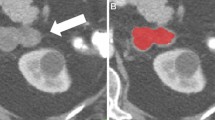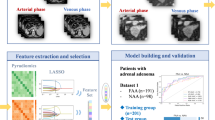Abstract
Incidental adrenal masses are seen in 5% of abdominal computed tomography (CT) examinations. Accurate discrimination of the possible differential diagnoses has important therapeutic and prognostic significance. A new handcrafted machine learning method has been developed for the automated and accurate classification of adrenal gland CT images. A new dataset comprising 759 adrenal gland CT image slices from 96 subjects were analyzed. Experts had labeled the collected images into four classes: normal, pheochromocytoma, lipid-poor adenoma, and metastasis. The images were preprocessed, resized, and the image features were extracted using the center symmetric local binary pattern (CS-LBP) method. CT images were next divided into 16 × 16 fixed-size patches, and further feature extraction using CS-LBP was performed on these patches. Next, extracted features were selected using neighborhood component analysis (NCA) to obtain the most meaningful ones for downstream classification. Finally, the selected features were classified using k-nearest neighbor (kNN), support vector machine (SVM), and neural network (NN) classifiers to obtain the optimum performing model. Our proposed method obtained an accuracy of 99.87%, 99.21%, and 98.81% with kNN, SVM, and NN classifiers, respectively. Hence, the kNN classifier yielded the highest classification results with no pathological image misclassified as normal. Our developed fixed patch CS-LBP-based automatic classification of adrenal gland pathologies on CT images is highly accurate and has low time complexity \(O(w \times h+k)\). It has the potential to be used for screening of adrenal gland disease classes with CT images.



















Similar content being viewed by others
Data Availability
The public data presented in this study are available from https://www.kaggle.com/turkertuncer/surrenal-image-dataset.
References
Jason DS, Oltmann SC: Evaluation of an adrenal incidentaloma. Surgical Clinics 99:721-729, 2019
Korivi BR, Elsayes KM: Cross-sectional imaging work-up of adrenal masses. World journal of radiology 5:88, 2013
Bharwani N, et al.: Adrenocortical carcinoma: the range of appearances on CT and MRI. American journal of roentgenology 196:W706-W714, 2011
Lattin Jr GE, et al.: From the radiologic pathology archives: adrenal tumors and tumor-like conditions in the adult: radiologic-pathologic correlation. Radiographics 34:805-829, 2014
Romeo V, et al.: The role of dynamic post-contrast T1-w MRI sequence to characterize lipid-rich and lipid-poor adrenal adenomas in comparison to non-adenoma lesions: preliminary results. Abdominal Radiology 43:2119-2129, 2018
Schieda N, Alrashed A, Flood TA, Samji K, Shabana W, McInnes MD: Comparison of quantitative MRI and CT washout analysis for differentiation of adrenal pheochromocytoma from adrenal adenoma. American Journal of Roentgenology 206:1141-1148, 2016
Allen BC, Francis IR: Adrenal imaging and intervention. Radiologic Clinics 53:1021-1035, 2015
Zhang G-M-Y, Shi B, Sun H, Jin Z-Y, Xue H-D: Differentiating pheochromocytoma from lipid-poor adrenocortical adenoma by CT texture analysis: feasibility study. Abdominal Radiology 42:2305-2313, 2017
Spartalis E, et al.: Metastatic carcinomas of the adrenal glands: from diagnosis to treatment. Anticancer research 39:2699-2710, 2019
Elmohr M, et al.: Machine learning-based texture analysis for differentiation of large adrenal cortical tumours on CT. Clinical radiology 74:818. e811-818. e817, 2019
Stanzione A, et al.: Handcrafted MRI radiomics and machine learning: classification of indeterminate solid adrenal lesions. Magnetic Resonance Imaging 79:52-58, 2021
Moawad AW, Ahmed A, Fuentes DT, Hazle JD, Habra MA, Elsayes KM: Machine learning-based texture analysis for differentiation of radiologically indeterminate small adrenal tumors on adrenal protocol CT scans. Abdominal Radiology:1–11, 2021
Romeo V, et al.: Characterization of adrenal lesions on unenhanced MRI using texture analysis: a machine‐learning approach. Journal of Magnetic Resonance Imaging 48:198-204, 2018
Yi X, et al.: Adrenal incidentaloma: machine learning-based quantitative texture analysis of unenhanced CT can effectively differentiate sPHEO from lipid-poor adrenal adenoma. Journal of Cancer 9:3577, 2018
Jayapriya K, Jacob IJ, Mary N: Person re-identification using prioritized chromatic texture (PCT) with deep learning. Multimedia Tools and Applications 79:29399-29410, 2020
Dharma D: Coral reef image/video classification employing novel octa-angled pattern for triangular sub region and pulse coupled convolutional neural network (PCCNN). Multimedia Tools and Applications 77:31545-31579, 2018
Marée R, Geurts P, Piater J, Wehenkel L: Biomedical image classification with random subwindows and decision trees. Proc. International Workshop on Computer Vision for Biomedical Image Applications: City
Poyraz AK, Dogan S, Akbal E, Tuncer T: Automated brain disease classification using exemplar deep features. Biomedical Signal Processing and Control 73:103448, 2022
Tuncer T, Dogan S, Baygin M, Acharya UR: Tetromino pattern based accurate EEG emotion classification model. Artificial Intelligence in Medicine 123:102210, 2022
Thanh DNH, Prasath VB, Hieu LM, Hien NN: Melanoma skin cancer detection method based on adaptive principal curvature, colour normalisation and feature extraction with the ABCD rule. Journal of Digital Imaging 33:574-585, 2020
Demir S, et al.: Automated knee ligament injuries classification method based on exemplar pyramid local binary pattern feature extraction and hybrid iterative feature selection. Biomedical Signal Processing and Control 71:103191, 2022
Barua PD, et al.: Multilevel deep feature generation framework for automated detection of retinal abnormalities using OCT images. Entropy 23:1651, 2021
Dosovitskiy A, et al.: An image is worth 16 × 16 words: transformers for image recognition at scale. arXiv preprint arXiv:201011929, 2020
Tolstikhin I, et al.: MLP-Mixer: an all-MLP architecture for vision. arXiv preprint arXiv:210501601, 2021
Singh R, Athisayamani S: Banana leaf diseased image classification using novel HEAP auto encoder (HAE) deep learning. Multimedia Tools and Applications 79:30601-30613, 2020
Goldberger J, Hinton GE, Roweis S, Salakhutdinov RR: Neighbourhood components analysis. Advances in neural information processing systems 17:513-520, 2004
Peterson LE: K-nearest neighbor. Scholarpedia 4:1883, 2009
Vapnik V: The support vector method of function estimation: Springer, 1998
Vapnik V: The nature of statistical learning theory: Springer science & business media, 2013
Wan EA: Neural network classification: a Bayesian interpretation. IEEE Transactions on Neural Networks 1:303-305, 1990
Mary NAB, Dharma D: Coral reef image classification employing improved LDP for feature extraction. Journal of Visual Communication and Image Representation 49:225-242, 2017
Frazier PI: A tutorial on Bayesian optimization. arXiv preprint arXiv:180702811, 2018
Ojala T, Pietikainen M, Maenpaa T: Multiresolution gray-scale and rotation invariant texture classification with local binary patterns. IEEE Transactions on pattern analysis and machine intelligence 24:971-987, 2002
Powers DM: Evaluation: from precision, recall and F-measure to ROC, informedness, markedness and correlation. arXiv preprint arXiv:201016061, 2020
Warrens MJ: On the equivalence of Cohen’s kappa and the Hubert-Arabie adjusted Rand index. Journal of classification 25:177-183, 2008
Ani Brown Mary N, Dejey D: Classification of coral reef submarine images and videos using a novel Z with tilted Z local binary pattern (Z⊕ TZLBP). Wireless Personal Communications 98:2427-2459, 2018
Ani Brown Mary N, Dharma D: A novel framework for real-time diseased coral reef image classification. Multimedia Tools and Applications 78:11387-11425, 2019
Yi X, et al.: Radiomics improves efficiency for differentiating subclinical pheochromocytoma from lipid-poor adenoma: a predictive, preventive and personalized medical approach in adrenal incidentalomas. EPMA Journal 9:421-429, 2018
Robinson-Weiss C, et al.: Machine learning for adrenal gland segmentation and classification of normal and adrenal masses at CT. Radiology:220101, 2022
Author information
Authors and Affiliations
Corresponding author
Ethics declarations
Conflict of Interest
The authors declare no competing interests.
Additional information
Publisher's Note
Springer Nature remains neutral with regard to jurisdictional claims in published maps and institutional affiliations.
Rights and permissions
Springer Nature or its licensor (e.g. a society or other partner) holds exclusive rights to this article under a publishing agreement with the author(s) or other rightsholder(s); author self-archiving of the accepted manuscript version of this article is solely governed by the terms of such publishing agreement and applicable law.
About this article
Cite this article
Sut, S.K., Koc, M., Zorlu, G. et al. Automated Adrenal Gland Disease Classes Using Patch-Based Center Symmetric Local Binary Pattern Technique with CT Images. J Digit Imaging 36, 879–892 (2023). https://doi.org/10.1007/s10278-022-00759-9
Received:
Revised:
Accepted:
Published:
Issue Date:
DOI: https://doi.org/10.1007/s10278-022-00759-9




